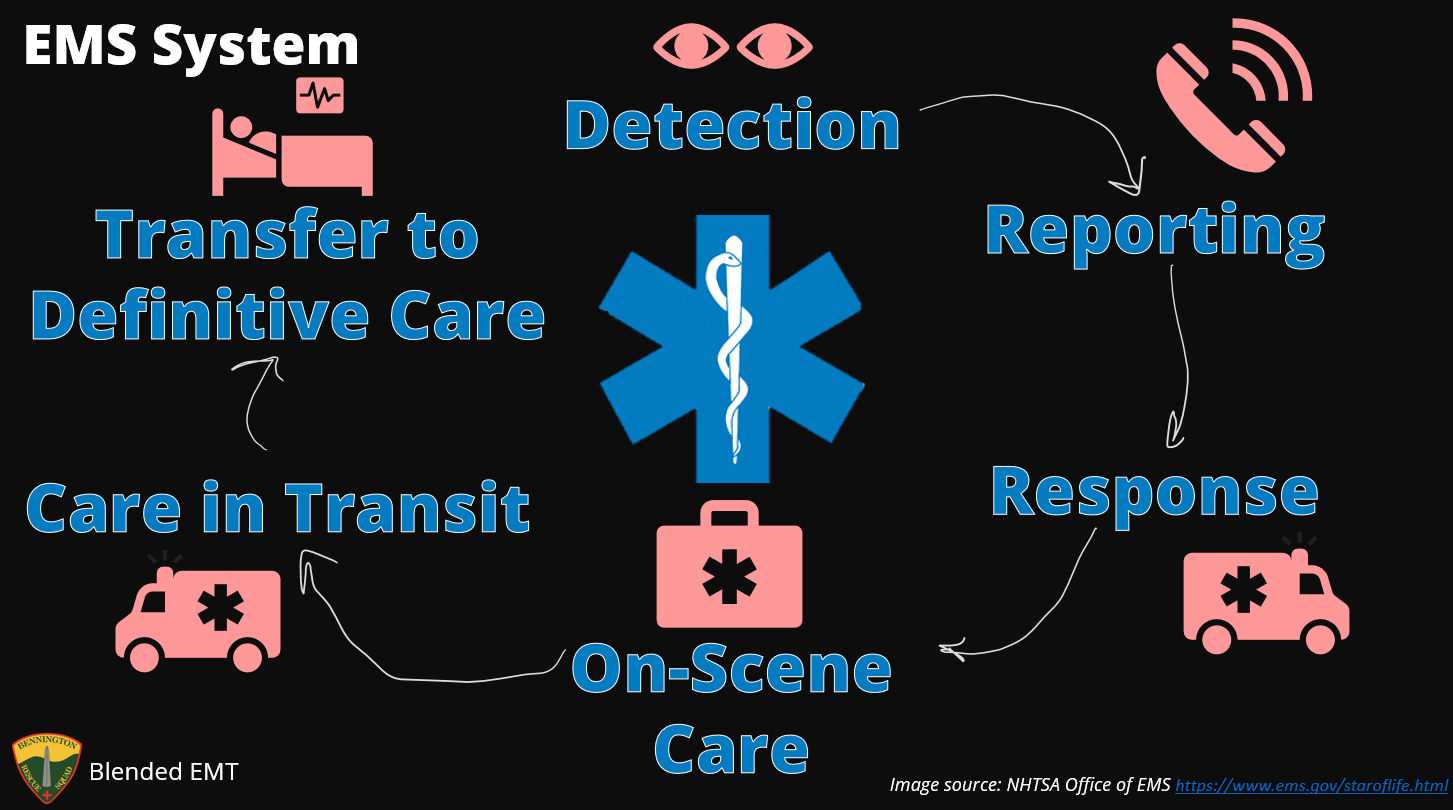The EMS system
what is ems?
Emergency Medical Services (EMS) is an integrated system for emergency medical treatment and transportation of sick and injured patients. EMS is a combination of healthcare, emergency management, public health, and public safety. EMS is represented by the Star of Life, each of the 6 points of the star represent a component of the EMS system (pictured here).
EMS is provided by any number of types of agencies including:
private, non-profit entities (like Bennington Rescue)
private, for-profit entities
third-service governmental entities
municipal entities like EMS departments, fire/EMS departments, or combination public safety departments.
You can learn more about EMS systems from Vermont EMS or the NHTSA Office of EMS.
our ems service area
Coverage Area: Bennington Rescue provides primary EMS for all of Bennington, Woodford, and a majority of Shaftsbury (pictured).
Level of Service: Our agency is an Advanced Life Support (ALS) and Critical Care Paramedic endorsed agency. See the descriptions below for the levels of care in Vermont EMS.
Regional Oversight: In Vermont, all EMS agencies operate in an EMS District. Bennington Rescue is in EMS District 12 along with EMS agencies within Bennington County and some Windham County EMS agencies. The EMS District agencies’ care is overseen by a physician, known as a District Medical Advisor (DMA) - ours is Dr. Sean Burns from Southwestern Vermont Medical Center.
Neighbors: We work in a system of mutual aid partners. Bennington Rescue responds mutual aid or with paramedic intercept service to our neighbors in Vermont and communities in NY of Hoosick/Hoosick Falls, Petersburgh, Cambridge, and White Creek.
ems levels of care in vermont
Vermont Emergency First Responders (VEFRs) is a basic first responder. The VEFR has a limited scope of practice including CPR, AED, bleeding control, assisting with an epinephrine auto-injector for anaphylaxis, assisting with a prescribed metered dose inhaler (rescue inhaler) with an asthma attack or COPD exacerbation, or administering naloxone. VEFR personnel’s role will vary by agency and may include community first response, event standbys, community demonstrations, or acting as a driver for a licensed ambulance crew (EMT, AEMT, or Paramedic).
Emergency Medical Responders (EMRs) provide immediate lifesaving care to critical patients who access the emergency medical services system. EMRs have the knowledge and skills necessary to provide immediate lifesaving interventions while awaiting additional EMS resources to arrive. EMRs have tools such as oxygen, airway devices, and can obtain vital signs. EMRs also provide assistance to higher-level personnel at the scene of emergencies and during transport. An EMR on an ambulance crew usually acts as a driver for a licensed primary patient care crew member (EMT, AEMT, or Paramedic) or as extra assistance during patient care.
Emergency Medical Technicians (EMTs) provide critical medical care to patients both on-site and in ambulances on their way to the hospital. EMTs perform this basic and critical medical care most frequently out of an ambulance, using the tools and resources available within it. EMTs can carry and provide treatments such as nebulizers for asthma, epinephrine for anaphylaxis, aspirin for suspected cardiac discomfort, etc. An EMT can be a primary care provider for a patient during transport. EMTs often partner with AEMTs or Paramedics to allow crew members to act as primary patient care provider for patients best suited to their level of care.
Advanced Emergency Medical Technicians (AEMTs) provide basic and limited advanced emergency medical care and transportation for critical and emergent patients who access the emergency medical system. AEMTs function as part of a comprehensive EMS response, under medical oversight. AEMTs perform interventions with the basic and advanced equipment typically found on an ambulance. AEMTs can provide treatments such as IV or intraosseous (into bone) lines for fluid and medication administration, expanded medication formulary, etc. The Advanced Emergency Medical Technician is a link from the scene to the emergency health care system. In Vermont, an AEMT crew is considered Advanced Life Support (ALS).
Paramedics are allied health professionals whose primary focus is to provide advanced emergency medical care for critical and emergent patients who access the emergency medical system. This individual possesses the complex knowledge and skills necessary to provide patient care and transportation. Paramedics function as part of a comprehensive EMS response, under medical oversight. Paramedics perform interventions with the basic and advanced equipment typically found on an ambulance. The Paramedic is a link from the scene into the health care system. Paramedic training takes about 18-24 months.









